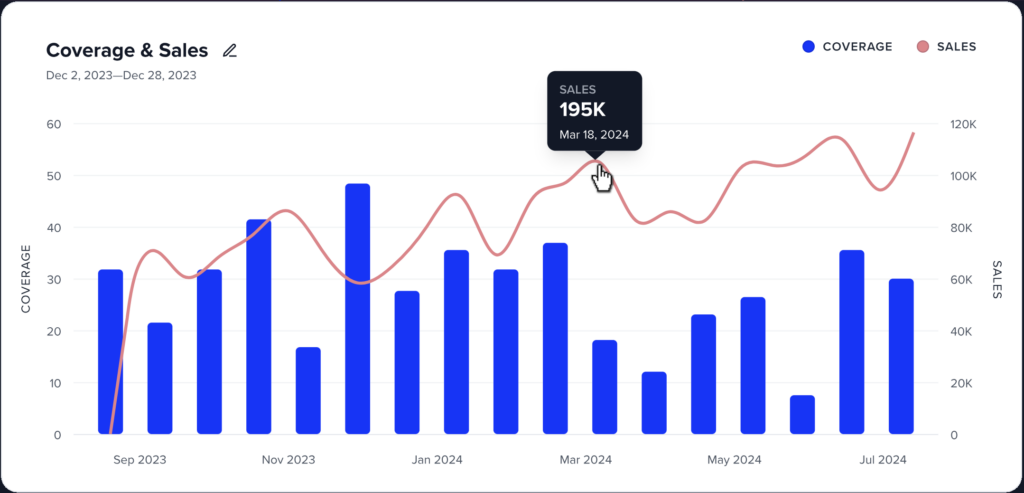Something is holding the PR industry back. It’s absence is known. But it’s starting to feel a little more serious day by day.
Impact.
The very thing PR can deliver. But few make an attempt to correlate their work with.
Hitting targets. Cost savings. Leads. Donations. Sales. Stock Price. Employee Satisfaction. Staff retention. You know. Real Impact.
Education is nudging the conversion along. Barcelona principles. Frameworks. Stop using AVEs. Pivot tables. AI?! There are no silver bullets. The valiant few are banging the drum. But on the ground, the pace of change is not fast enough.
Introducing CoverageImpact
A new tool you can try for free today – coverageimpact.com
It’s a simple tool. That hopefully can deliver outsized impact.
Turn your tracker spreadsheet into a coverage-over-time graph in a flash. Layer on data like sales, web traffic or search trends and connect PR activity to organisational impact.
Here is a video of me making a coverage vs Google Trends graph. Have a play yourself.
To start, we’re releasing the first version of this tool for free. We have lots of ideas on where it can go. My hope for 2024, is to shortcut PR people into getting curious and asking questions about correlation.
Then, if they want answers about the actual incremental impact and causation of PR they can learn more about other marketing mix modelling approaches. But for now, how many new credible conversations can CoverageImpact start?
Can we get 1000s of PR pros moving in this direction all over the world? Not just the geeky few. Or those who can afford the data and evaluation experts. Let’s see. This won’t be the only answer. But we think it’s time for a step change.
Why the lack of Impact reporting is damaging the PR industry
PRovoke Media’s annual compilation of the most influential in-house communicators ‘The Influence 100’ reported that there was a drop in public relations investment of more than $1bn, from $4.8bn to $3.7bn in 2023.
The 2024 Global Comms report from Cision and PR Week found the top challenges for PR this year will be securing budgets (48%) and the inability to measure impact effectively (50%).
In a recent podcast interview industry commentator and founder of Wadds Inc Stephen Waddignton said “When it comes to measuring impact; PR tends to focus on the media perspective and reputational perspective rather than actually what management wants and expects; aligning with the P&L or the balance sheet. There’s a fundamental mismatch there. A lot of practitioners just aren’t very good at making that alignment and understanding the business context within which they operate and fundamentally understand what drives business and how it creates value for its shareholders.”
Recent global research of over 350 PR professionals carried out by CoverageBook in February 2024 found a significant disconnect between how the PR industry measures and reports on activity, and what senior leaders and budget holders expect to see. The survey showed that just one third of PR pros align their activity with commercial goals, and less than half of PR professionals currently consider new biz and sales when measuring the impact of their work.
The world’s largest PR agencies such as Hill & Knowlton and Golin have been able to invest in hiring data and analyst talent inhouse and this has resulted in enhanced measurement, great ‘PR outcome’ case studies and AMEC award wins.
So why is the rest of the industry lacking to do the same?
In a recent interview with ‘Experienced Media Analysts’ founder, AMEC board member and PR measurement expert Steph Bridgeman highlighted a simple skills issue “Benchmarks, past data and over time data and trends are really important. Some of the challenges that PR organizations have had is the ability to gather historic data but it’s so much easier now, there’s more readily available data. But then there’s just a practical level; It’s the skill of actually having two data sets and then knowing how you plot them on the same graph. I know how to do it because I do it in Excel, but putting one thing on one axis and one thing on another axis – it’s actually very complex to do!”
A huge 98% of PR professionals in 2023’s CoverageBook survey said they didn’t have access to an external measurement team and 68% of agencies asked didn’t have in-house analysts either, revealing there is a clear skills gap between analysing and visualising PR and organisational results.
In the most recent research, when asked about the biggest challenges they face in measurement, 52% of all respondents cited a lack of measurement tools. These findings underscore the urgent need for tools that simplify measurement and reporting, making it easier for PR professionals to demonstrate the value of their work.
